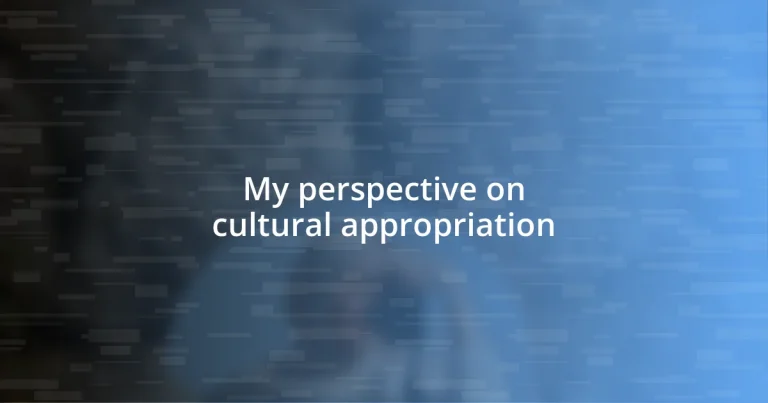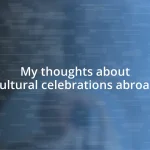Key takeaways:
- Cultural appropriation involves taking elements from one culture without permission or understanding, often perpetuating stereotypes and ignoring the significance behind those elements.
- Distinguishing between cultural appreciation and appropriation hinges on intent and respect; genuine appreciation involves engagement and learning, while appropriation often lacks understanding.
- Action against appropriation requires advocacy, supporting cultural creators, and fostering open conversations to promote understanding and respect for cultural identities.
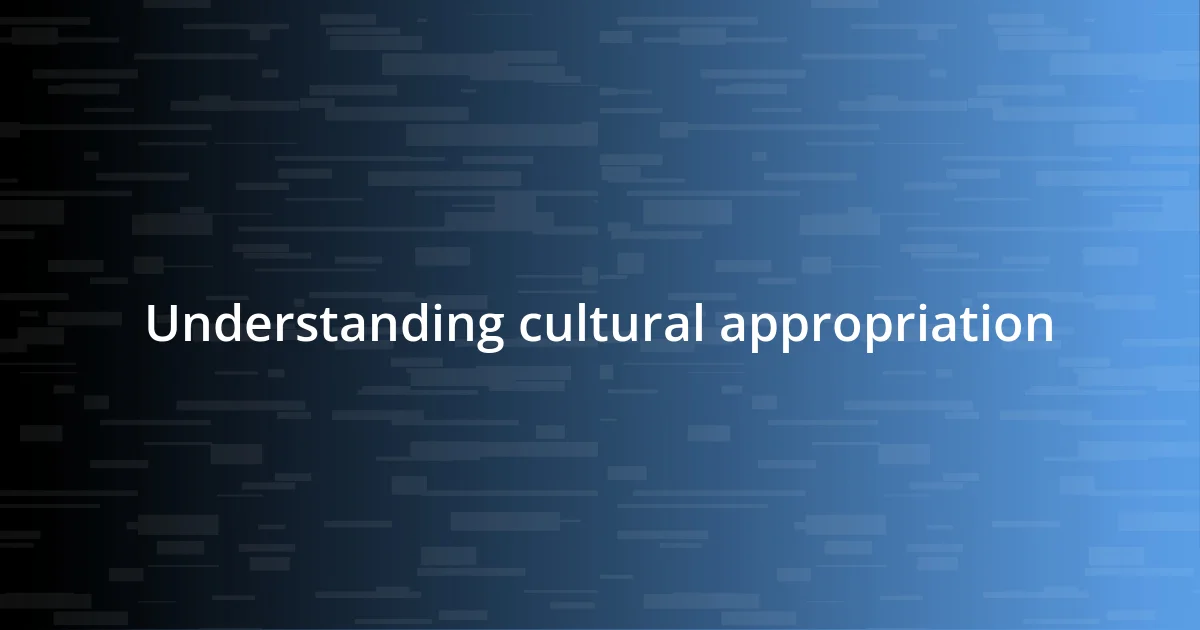
Understanding cultural appropriation
Cultural appropriation, at its core, involves taking elements from one culture, often by members of a historically dominant culture, without permission or understanding. I remember a time when I saw a fashion line using traditional Native American designs. It felt like a stark reminder of how easily one can overlook the deep significance and history behind those patterns. Does it make you wonder about the stories we might be erasing in the pursuit of trendiness?
Exploring cultural appropriation invites us to consider our own experiences and motivations. For instance, when I took a yoga class, I appreciated its roots in Hindu philosophy, but I couldn’t shake the feeling that participating without acknowledging its cultural significance might feel disrespectful. Have you ever participated in something you loved but later questioned its origins? These reflections are essential for understanding not just the action itself, but the context surrounding it.
It’s also important to recognize that cultural appropriation can perpetuate stereotypes and reinforce power imbalances. There was a moment during a festival when I noticed someone wearing a costume mimicking a culture they had no connection to, and it sparked a realization about how these appearances can dismiss the real struggles faced by marginalized communities. How can we celebrate other cultures while ensuring respect and authenticity are maintained? Engaging in these questions can deepen our understanding of cultural dynamics in society.
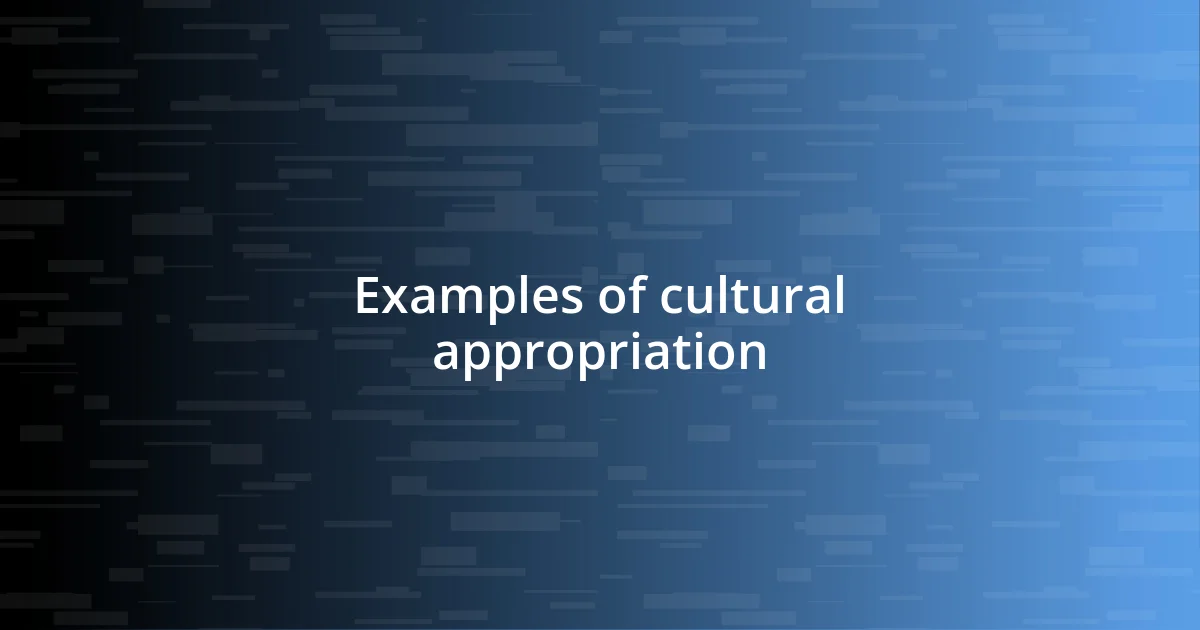
Examples of cultural appropriation
Cultural appropriation often surfaces in fashion, where designers may borrow from indigenous clothing styles without acknowledging their significance. I recall watching a runway show that featured traditional African prints; while they were beautifully crafted, it struck me that the models were wearing them without understanding the cultural stories behind those designs. It made me question: what does wearing these garments mean to those who belong to the culture they originated from?
Another poignant example is hairstyle appropriation. There was a time when box braids became trendy among non-Black individuals, and I saw friends posting selfies flaunting these styles. While hair can be a form of self-expression, this particular trend led to conversations about the historical and cultural significance of braids in Black communities. It’s disheartening to think that what many consider a fashionable choice can also be a form of disregard for the struggles of a historically marginalized group.
Lastly, think about music. When popular artists incorporate elements from different cultural traditions without giving credit, it can feel like a dilution of the original art. I remember feeling a bit conflicted when a pop song sampled a traditional Native American melody; the catchy beat overshadowed the rich cultural narrative behind it. How does it feel for artists who struggle to preserve their heritage when their melodies are turned into mere background tracks for mainstream success?
| Example | Description |
|---|---|
| Fashion | Designers using indigenous styles without permission |
| Hairstyles | Non-Black individuals adopting box braids |
| Music | Pop artists sampling traditional cultures’ melodies |
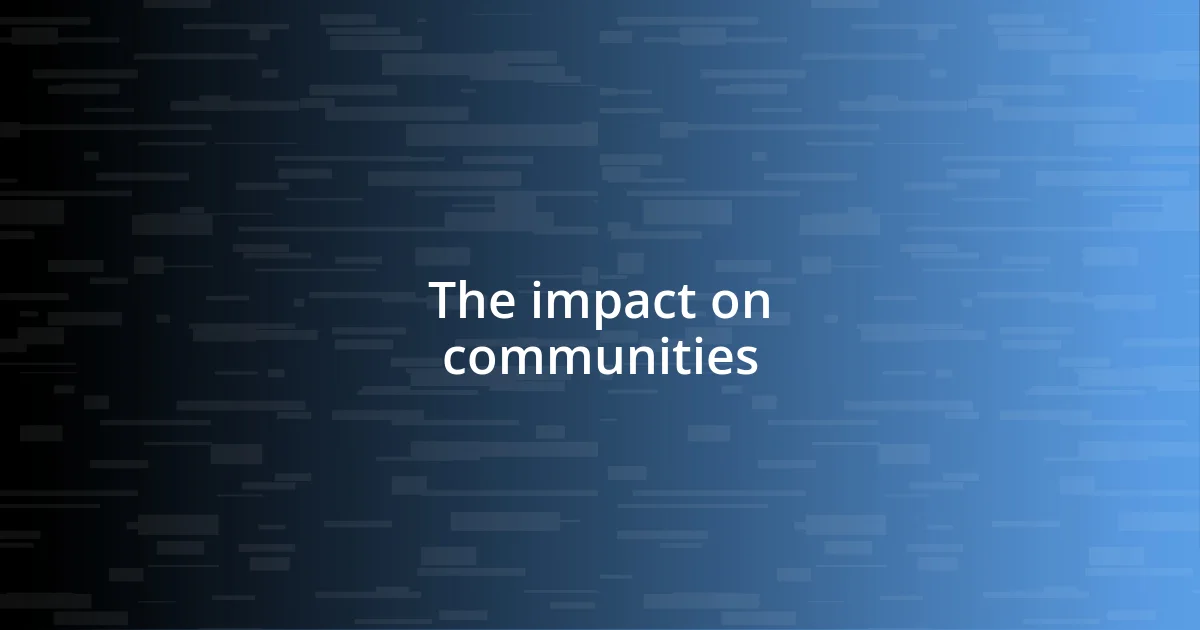
The impact on communities
Cultural appropriation profoundly affects communities, often leading to feelings of erasure and exploitation. I recall a conversation with a friend from a Native American background who shared her frustration about how sacred rituals were commercialized for entertainment. It made me realize that for many individuals, these appropriated elements aren’t just aesthetic choices but are tied to their identity and heritage. When their culture is randomly taken and reshaped into something trivial, it undermines years of tradition and significance.
- It can perpetuate systemic inequalities, as dominant cultures profit from the very elements that marginalized communities have struggled to protect.
- Often, the stories and meanings behind cultural symbols are ignored, leading to an incomplete picture of their true value.
- Communities may face increased stereotyping, as their rich, multifaceted identities get reduced to simplistic trends.
I’ve also noticed how these dynamics can breed resentment among community members. At a gathering, I heard a passionate discussion about the portrayal of Indigenous cultures in films; many felt frustrated that their stories were told without their input or consent. It’s crucial to understand that appropriation is more than just borrowing; it’s about power, respect, and the narratives that go unheard when a dominant culture sets the stage.
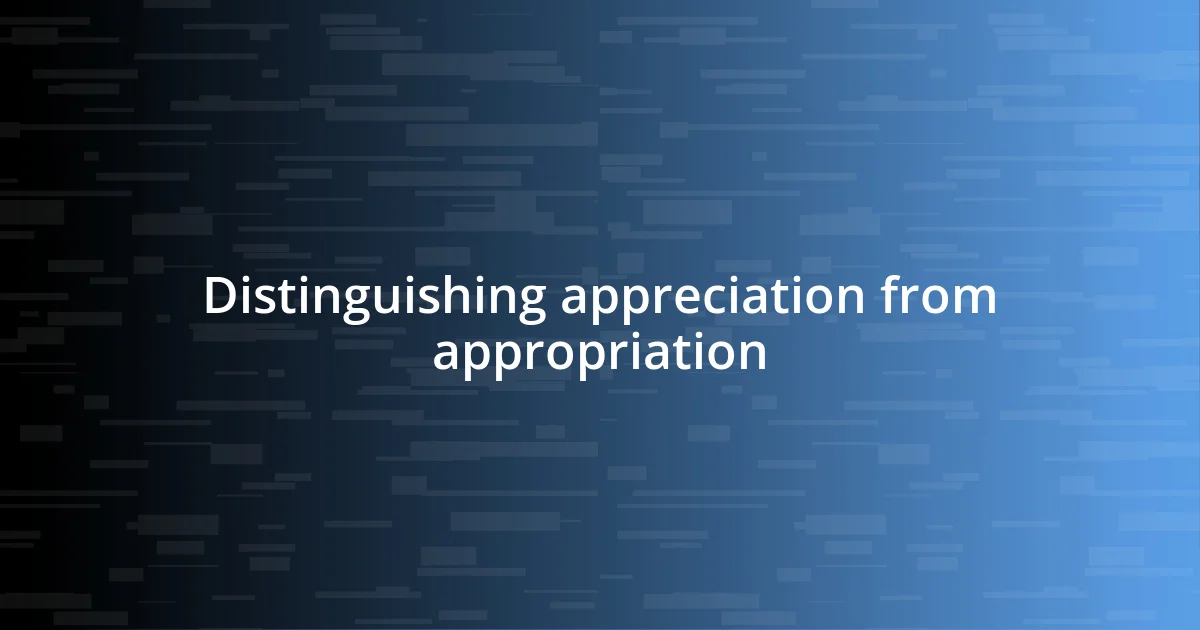
Distinguishing appreciation from appropriation
The line between cultural appreciation and appropriation can sometimes feel blurry. I think a key distinction lies in intent and respect. For instance, when I attended a cultural celebration and admired traditional dances, I felt a deep sense of appreciation for the history and community behind those movements. I was there to learn and honor, not to mimic for my own gain. This experience really highlighted for me how crucial it is to approach different cultures with curiosity and respect rather than simply adopting elements for personal use.
I’ve noticed that appreciation often comes with a willingness to engage and educate oneself about the culture in question. When I wore a beautifully crafted kimono to a friend’s wedding, I took the time to understand its significance. I learned about the symbolic meanings of the colors and patterns and shared those insights with others at the event. This kind of interaction transforms clothing from merely a fashion statement into a shared conversation. It prompts the question: Are we engaging in cultural exchange, or are we simply taking?
In contrast, appropriation seems to happen when there’s a lack of understanding or respect for the original context. I can recall a time when a popular music festival showcased a Native American dance group, yet the ads predominantly featured non-Indigenous performers in feathered headdresses. Those mixed messages left me unsettled. It felt like a celebration that excluded the very people who should have been at the forefront. Reflecting on that, I often wonder how many opportunities are missed when cultures aren’t represented authentically, and what that means for the integrity of those traditions.

Responsible engagement with cultures
Responsible engagement with cultures calls for a mindful approach that emphasizes dialogue and learning. I remember participating in a workshop focused on African drumming and dance, where the facilitators shared not just the rhythms but the stories that each beat carried. It was a real eye-opener, reminding me that each cultural practice holds a history that deserves to be honored. This kind of engagement made me feel grateful to learn and appreciate, rather than just replicate for entertainment.
I’ve also seen how vital it is to support cultural creators directly. When I bought handmade crafts during a local festival, I asked the artisans about their methods and inspirations. Hearing their stories truly enriched my appreciation and allowed me to recognize the effort and meaning woven into their work. This not only fosters respect but also empowers communities to thrive, making it a win-win situation for everyone involved. Isn’t it interesting how our interactions can either elevate a culture or strip it of its depth?
It’s essential to check our motivations when engaging with other cultures. I reflect on moments when I’ve seen friends donning traditional attire without understanding its significance. It sparked in me a desire to ask, “Are we connecting deeply, or merely dressing up for a photo-op?” Engaging responsibly can turn those surface-level interactions into profound experiences that unite us, showing that culture is not just a backdrop but a living narrative that we all play a part in.
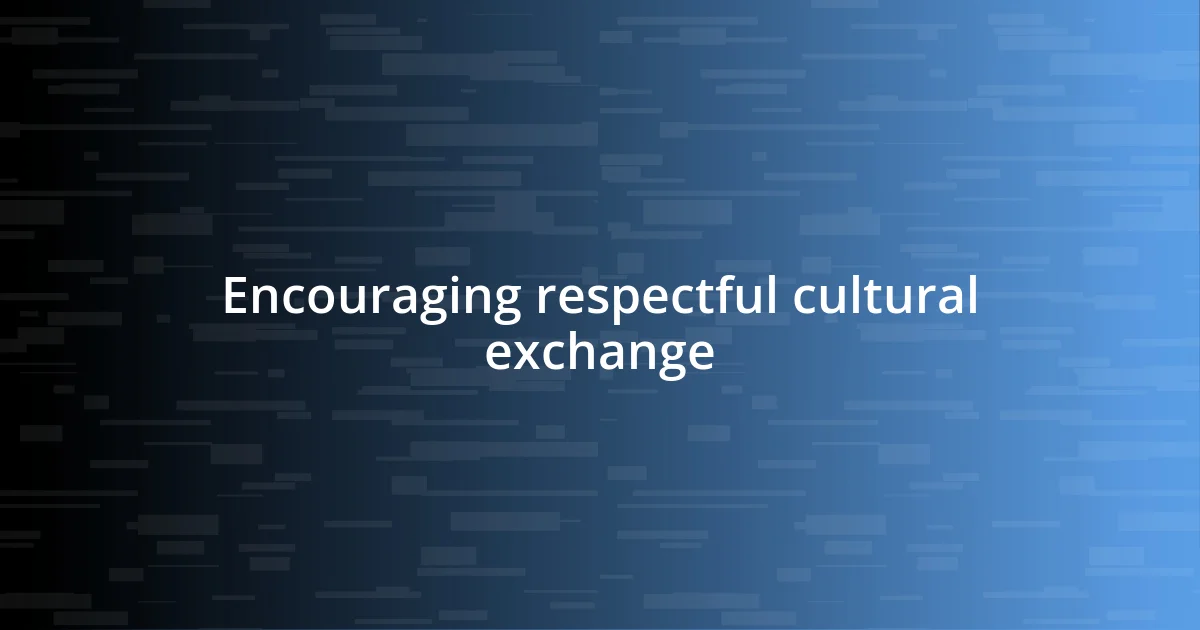
Encouraging respectful cultural exchange
Encouraging respectful cultural exchange starts with listening and learning. I recall attending a series of community lectures on Indigenous histories, where speakers shared not just facts but their personal stories. It struck me how storytelling forms the backbone of cultural identity. This exchange opened my eyes to nuances I had previously overlooked, reinforcing my belief that respect grows from genuine curiosity.
I often find that participating in cultural events with an open heart creates bonds that transcend mere observations. For instance, during a potluck celebrating various heritages, I was invited to taste dishes from different cuisines while sharing recipes from my own background. It felt like we were weaving our histories together, creating a beautiful tapestry of flavors and traditions. Why do we often forget that food is not just nourishment but a means of connection?
The key to fostering meaningful cultural exchange lies in mutual respect. I remember a friend who enthusiastically wore a traditional outfit to a dance party without being aware of its origins. When I gently pointed it out, she took a step back, acknowledging the importance of understanding what she wore. It made me realize how our conversations can spark reflection, helping us shift from appropriating to appreciating. I think that when we engage thoughtfully, we honor the rich legacies that each culture shares, creating a space where we can all learn and grow together.

Taking action against appropriation
Taking action against appropriation requires us to move beyond mere awareness into meaningful advocacy. I remember a time when I joined a local activism group focused on protecting Indigenous cultures and practices. It was invigorating to see a community channeling energy into workshops and discussions that educated others about the impacts of appropriation. Have you ever experienced that thrilling moment when collective voices come together for a cause? It’s powerful and inspiring.
Engagement doesn’t simply stop at conversation. When I discovered a nearby cultural festival facing backlash for commercialization, I rallied friends to support local vendors directly. By choosing to spend our money there, we not only celebrated their heritage but also sent a message: culture should be valued and respected, not exploited. How often do we consider the influence of our choices on the communities we admire? The ripple effects can be significant.
One of the most impactful steps I’ve taken is addressing appropriation directly with those involved, even when it feels uncomfortable. I once overheard someone at a gathering making light of a cultural practice that held deep significance. Instead of remaining silent, I spoke up, sharing insights I had gained about its importance. This moment was nerve-wracking, but it opened the door for a deeper conversation about understanding and respect. Isn’t it fascinating how a simple dialogue can pave the way for change?












